Recently I received the Fantastic Fall edition of a rather upscale catalog featuring “inspired home décor.” I was shocked to see that 33 pages - more than a third of the magazine – were dedicated to Halloween décor - macabre mummies, gaggles of ghosts, skull and bones necklaces and purses, and much more.
There was a 12-foot indoor spider web with jewel-eyed black spiders, also a witch so richly detailed “you’ll expect her to take off on her broom.” Every kind of outdoor décor was featured: orange “Halloween lights,” life-size vampires, grim reapers and ghosts, and even an inflatable carriage hearse complete with lights, sound effects and a rising zombie (at a truly frightening price). For the mantelpiece, black candleholders with flickering candles and a black mantel scarf with cobweb or belfry bat patterns.
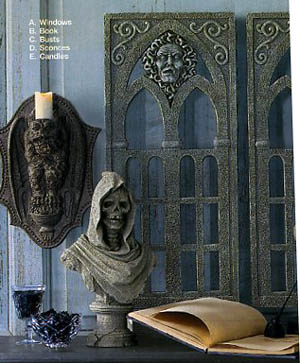
Macabre year-round "Halloween decor"
|
Do you really believe witchcraft isn’t finding a place in the mainstream culture? It’s time to wake up. This 2007 catalog aimed at the general public is featuring handsome bound leather books for your favorite spells and potions. Ghoulish gargoyle sconces and sculptures and gothic windows with skulls are advertised to be not just for Halloween, but year-round display.
The ancient pagan feast day, today known as Halloween, has come to be considered a major “holiday,” as important as Christmas and Easter in the minds of many children and adults. This fulfills a goal of the neo-pagans – to reclaim the pagan festivals that were made holy days by the Catholic Church.
On one Wicca site, a witch swore her revenge on the Christians who “have pushed Christmas down our throats every year.” She asserted, “We will do the same with Halloween - make you adopt and accept our feast day, symbols and beliefs, whether you like it or not, whether you know it or not.” Another gloated, “More and more persons are claiming Halloween as their favorite holiday! Hurrah for Samhain (the pagan name for Halloween)! Hurrah for the triumph of Paganism over Christianity. Your sun is setting, Christians, and ours is rising.”
The History of Samhain
What we know as Halloween started as Samhain (pronounced Sah-Ween), the most popular of the eight pagan Celtic feasts in the yearly cycle. Our trick-or-treat, witches, mayhem, costuming and bonfires are vestiges of this pagan festival. By the way, you might be surprised to know that the Catholic countries of Europe and South America never celebrated Halloween.
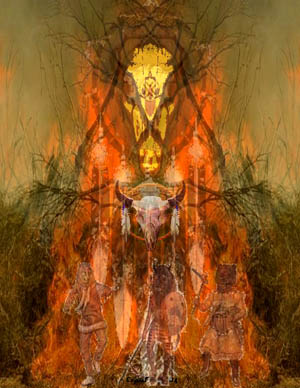
Spirits rising in the pagan Celtic bonfire ritual on October 31 |
For the Celtic pagans, Samhain marked the end of the year and the Autumn season that faded into history at dusk on October 31. The essence of Samhain is chaos and disintegration; a three-day period called “Time Which Is No Time,” when the normal order was suspended. This chaos manifested itself not only in an unleashing of the spirit world on the earth, but in dark occult rituals and night orgies led by the Druid priests and witches. Disorder reigned: men dressed as women and women as men, people wore costumes of ghouls and ghosts to mix with the evil spirits or fool them so they would pass by without incident.
During the three days of Samhain, the Druid priests would make contact with the spirit world, departed relatives or the spirits that lived in the underworld who would give supposed guidance and inspiration for the new pagan year that was starting. During these days, the veil was said to be drawn that separated this world and the underworld, and journeys could be made from one side to the other. As in voodoo rituals, families set out food and wine for the spirits of their ancestors to refresh themselves after the long journey from the netherworld of Hell. Sweets were placed to appease wandering spirits. Then there were the uncontrollable evil spirits that came forth from the caves to devastate the land. Costumed Druid priests would parade about making loud noises to drive unwelcome spirits to the edge of town. Today it has become fashionable to make light of ghosts, spirits and such as just silly stories, but the pagans take them very seriously.
The pull of Samhain was darkness, the spirit world, divinations, and blood sacrifice. Again, as in voodoo, Druids predicted the future by reading the entrails and movements of the animals slaughtered for the great feast, known as the festival of meat. There were also human offerings to the demon gods, a frequent and common element in the religious rituals that were made only in the presence of a Druid. On the eve of Samhain, the Druid priests would burn the sacrificial animals in huge bonfires on hilltops at the “Fire Festivals.” For this reason the Full Moon in October was often referred to as the Blood Moon. They also used the fires to predict the future.
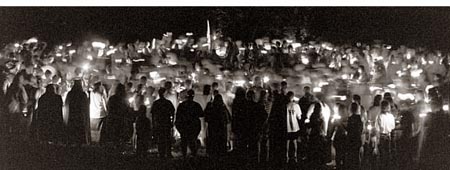
An opening Samhain ritual to the Devil, revived today in many places |
Today you will see that the druids, witches and wiccans of the neo-pagan movement vehemently deny and carefully hide the demonic aspects of the ancient cults and rituals they are reviving. They make no secret, however, that they are adoring the god of the Underworld and the Crone Witch goddess at their Samhain (also spelled Samhein or Sanhaim) festivals.
Halloween Christianized
With her good sense and wisdom, the Catholic Church took those pagan festivals and Christianized them, cleansing them of what was evil and demonic, maintaining what was sound or harmless, and adding what was holy and beneficial.
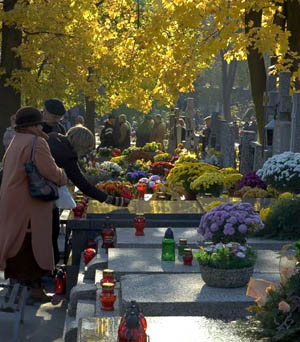
In Poland, Catholics decorate the tombs of relatives and pray for them on All Saints Day |
Therefore, in the 7th century Pope Boniface IV introduced All Saints Day to replace the pagan festival of the dead observed on May 13 in the West. In 835, in part to halt the Druid practices in the Celtic lands, Pope Gregory IV changed the date of All Saints Day to November 1.
The bonfires were still lit in the Celtic villages on the night of October 31, but now to give light to the evening of festivities and games and keep away the spirits of darkness. Thus Samhain became All Hallows Eve, the holy eve before All Saint’s Day, later shortened to Halloween. Instead of attending occult rituals to the devils, the Celtic people assisted at Holy Mass on November 1, celebrating with joy all the Saints in Heaven. Families visited cemeteries to decorate graves with candles and flowers and pray for their loved ones.
On the next day, November 2, All Souls’ Day, they joined the universal Church in praying for the souls of their deceased relatives and friends. Instead of leaving wine and food to appease the spirits, the people baked little pastries called “soul cakes” that were blessed and eaten at gatherings and distributed to the poor. The pagan festival had been Christianized.
Neo-Paganism revived
Neo-Paganism and Satanism are on the rise everywhere today, and at no time is it so obvious as at Halloween. Today’s witches and warlocks are openly practicing their Samhain rituals offered to the demonic spirits. The neo-pagans even advertise their festivals, acclimating the public to the worship of the Devil by introducing them to their less alarming rituals.
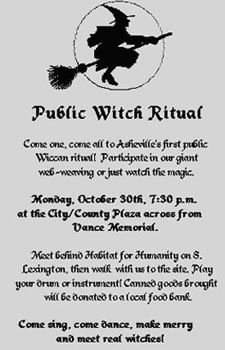
The public is invited to the Witch Festival |
For example, the 2007 Samhain Festival at Circle Sanctuary Nature Preserve (25 miles west of Madison, Wisconsin) calls on the public to come ”explore the afterlife, connect with the recent dead and ancestors, walk the Labyrinth and draw tarot cards.” There is a special program for the children, with mask making and spirit bags games. The pretext for all this revival of Paganism, Witchcraft and Satanism is to offer some fun for children and diversion for adults…
Here is another advertised event: The New York Witch Festival claims 2007 will be its biggest and best ever, with Sacred Circles, tarot card readers, and a Samhain ritual inviting the spirits of the departed to join the living. They do not hide that the festival is “offered to the community in honor of the goddess.” Isn’t this goddess the Devil?
Signs of the rise and acceptance of Neo-Paganism are everywhere. Anyone who visits a bookstore will find special sections at Halloween on magic, potions, spells, witches and vampires. One need go no further than e-bay to purchase a “Samhain blend” of Magickal Herbs, “specially blended for use in Samhain spells and rituals,” along with a Magickal Herbs eBook to learn the spells and uses.
Halloween is treated as an important date in the world of wizards and magic in the Harry Potter book series. The name Samhain appears as a title of a song from the album Mythical and Magical by a Heavy Metal band Pagan Altar. An article in the New York Daily News features an ex-Catholic mother who became a witch and celebrates “Samhain, not Halloween.” If you look around you, you will find signs that Halloween is increasingly turned toward the occult.
Let Christianity re-triumph
As Paganism revives, Halloween becomes more and more incompatible with Catholic Faith. Some 20 years ago, neither adults nor children took witches or ghosts seriously; Halloween was just a night to go out in a costume and get a bagful of candy. Perhaps it was a lack of vigilance.
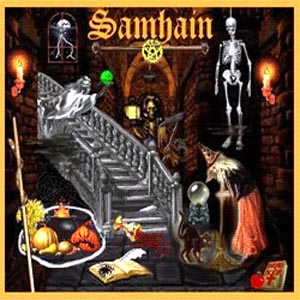
Readily available to all: A Samhain manual with spells and rituals to communicate with the dead |
At any rate, in the present climate, the witches and wizards have returned with a vengeance. They are taking themselves seriously and asking our children to do so also. The pagans are taking advantage of the symbols of Halloween to breathe life into their pagan festival of Samhain with its rituals to the devils of the underworld. The underworld, which sounds a bit glamorous, should be exposed for what it really is, Hell.
In this context, it behooves Catholics to rethink the practices of Halloween. We have our Catholic feast days, the holy days established by the Church to give honor and glory to God and celebrate the Saints in Heaven and Poor Souls in Purgatory.
Let’s do as the Church always did, crush out the pagan practices and customs, and emphasize what is salutary and good for souls. Let’s not decorate our homes with witches, spider webs and bats. Instead of dressing as ghouls and vampires, children can wear costumes of their favorite saints to commemorate the approaching holyday. There’s no need to do away with Halloween, just get rid of pagan practices and symbols, and make it what it should be, a “holy eve” before our Catholic feast days.

Posted on October 25, 2007

Related Topics of Interest
 Halloween - A Return to Paganism Halloween - A Return to Paganism
 Secret Spells Barbie and the Tendential Revolution Secret Spells Barbie and the Tendential Revolution
 Satanism on the Rise Satanism on the Rise
 The Subtle Invasion of Satanism The Subtle Invasion of Satanism
 Satanism in the Man's Domain Satanism in the Man's Domain
 Harry Potter and the Problem of Good and Evil Harry Potter and the Problem of Good and Evil
 Satanism and the Incompetent Roman Curia Satanism and the Incompetent Roman Curia

|